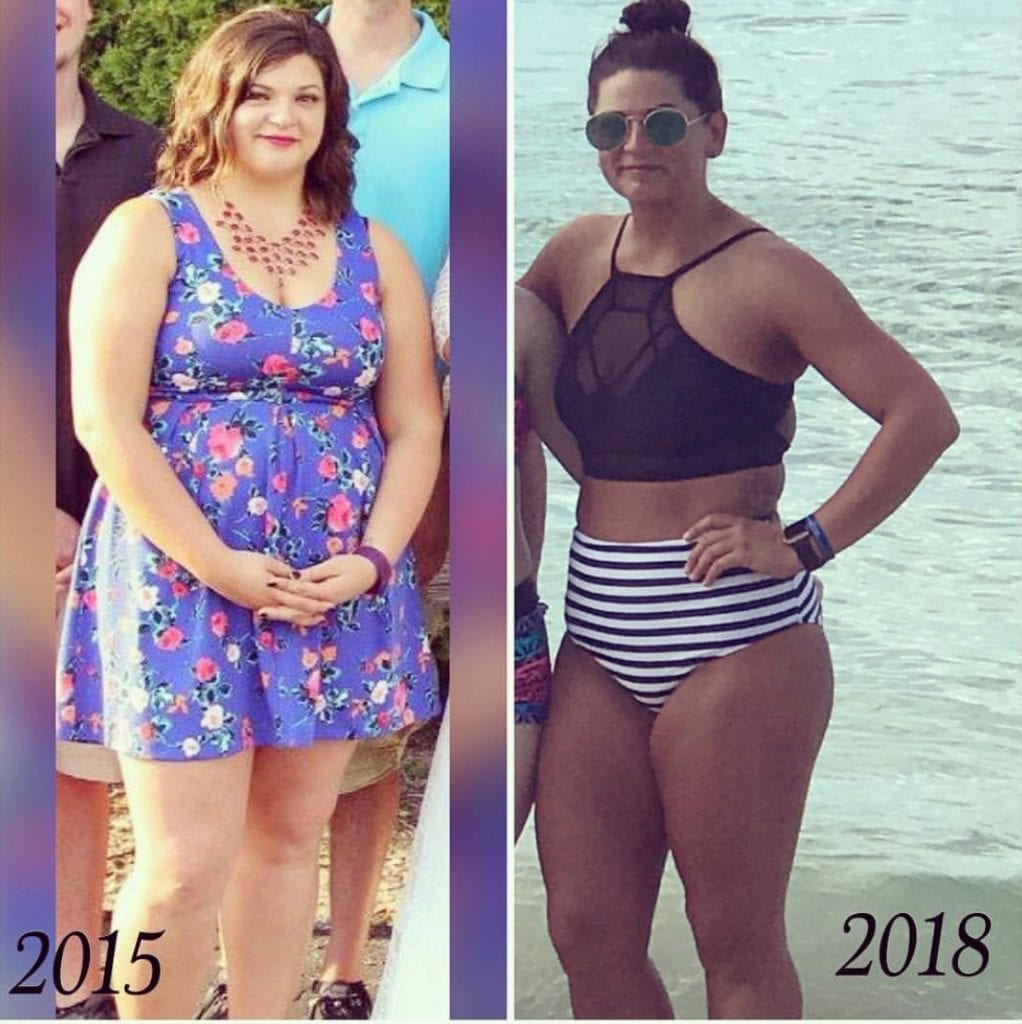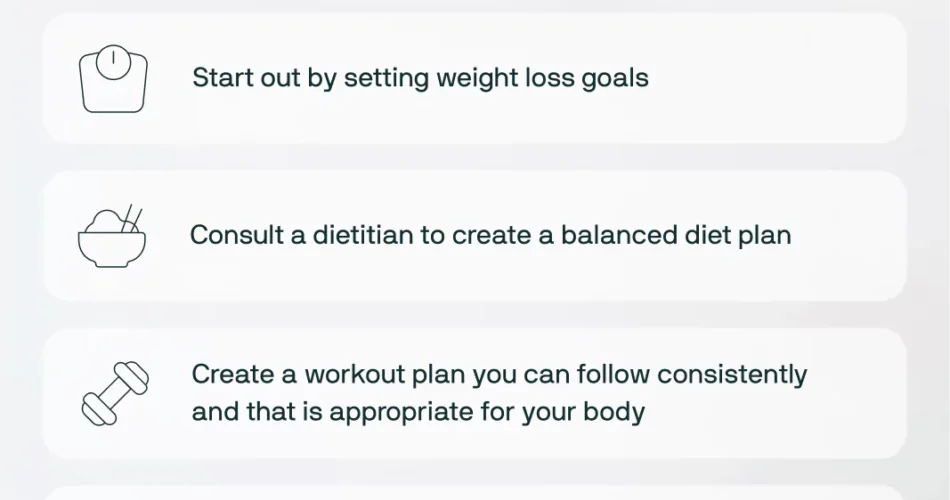Begin your weight loss journey by setting realistic goals and creating a balanced diet plan. Incorporate regular physical activity into your routine.
Starting your weight loss journey can feel overwhelming, but a structured approach makes it manageable and effective. Begin by setting clear, achievable goals that keep you motivated. Focus on a balanced diet rich in vegetables, lean proteins, and whole grains.
Avoid highly processed foods and sugary drinks. Regular physical activity, such as walking, jogging, or yoga, helps burn calories and improve your overall fitness. Track your progress to stay accountable and make adjustments as needed. Remember, consistency and patience are key. Seek support from friends, family, or a fitness community to stay motivated.

Credit: burnbootcamp.com
Embarking On A Weight Loss Journey
Starting your weight loss journey can be both exciting and challenging. It’s important to begin with a clear plan and mindset. This will help you stay focused and motivated throughout the process.
Setting Realistic Goals
Setting realistic goals is crucial for long-term success. Aim for small, achievable goals rather than drastic changes. For instance, aim to lose 1-2 pounds per week.
- Start Small: Begin with simple changes like drinking more water.
- Stay Consistent: Consistency is key for lasting results.
- Track Progress: Keep a journal to monitor your progress.
Understanding Your ‘why’
Understanding your ‘why’ helps you stay motivated. Ask yourself why you want to lose weight. Is it for better health? To feel more confident?
| Reason | Benefit |
|---|---|
| Health | Reduce the risk of chronic diseases. |
| Confidence | Feel better in your own skin. |
Nutritional Foundations For Weight Loss
Starting a weight loss journey can feel overwhelming. Building a solid nutritional foundation is essential. Understanding the basics of nutrition helps you make smarter food choices. Let’s explore key components of a healthy diet that supports weight loss.
Balanced Diet Basics
A balanced diet includes all essential nutrients your body needs. Focus on incorporating a variety of foods from each food group. Here’s a simple guide to what your plate should look like:
| Food Group | Examples | Benefits |
|---|---|---|
| Fruits | Apples, Berries, Oranges | Rich in vitamins and fiber |
| Vegetables | Broccoli, Spinach, Carrots | High in vitamins and minerals |
| Proteins | Chicken, Fish, Lentils | Builds and repairs tissues |
| Grains | Quinoa, Brown Rice, Oats | Provides energy and fiber |
| Dairy | Milk, Yogurt, Cheese | Rich in calcium and protein |
Portion Control And Mindful Eating
Understanding portion sizes is crucial. Use smaller plates to control portions. Here are some tips:
- Fill half your plate with vegetables.
- Use your hand to measure portions:
- A fist for carbs.
- A palm for proteins.
- A thumb for fats.
Mindful eating means paying attention to what you eat. Avoid distractions like TV or phones during meals. Chew slowly and savor each bite. This helps you enjoy your food and recognize when you are full.
The Role Of Physical Activity
Embarking on a weight loss journey requires more than just dietary changes. Physical activity plays a crucial role. It not only burns calories but also boosts your metabolism. Engaging in regular exercise can improve overall health. It enhances mood and increases energy levels. Let’s explore how to incorporate exercise effectively.
Choosing The Right Exercise
Finding the right exercise is essential. Start with activities you enjoy. This increases the chances of sticking with it. Consider the following options:
- Walking: Easy and accessible for most people.
- Running: Burns more calories in less time.
- Cycling: Great for low-impact cardio.
- Swimming: Full-body workout, gentle on joints.
- Strength Training: Builds muscle and boosts metabolism.
Each activity has its benefits. Choose one that fits your lifestyle. Mix different exercises to keep it interesting.
Consistency Over Intensity
Consistency is the key to effective weight loss. It’s better to exercise regularly. Short, daily workouts are more effective than sporadic intense sessions. Here’s a simple plan to follow:
| Day | Activity | Duration |
|---|---|---|
| Monday | Walking | 30 minutes |
| Tuesday | Strength Training | 20 minutes |
| Wednesday | Cycling | 30 minutes |
| Thursday | Walking | 30 minutes |
| Friday | Swimming | 20 minutes |
| Saturday | Running | 30 minutes |
| Sunday | Rest | – |
Stick to this schedule. Adjust as needed based on your progress. Your body will adapt and improve over time.

Credit: m.youtube.com
Crafting Your Weight Loss Plan
Starting your weight loss journey can be daunting. Crafting a well-thought-out plan is crucial. A tailored plan will guide you and keep you motivated. Below, we discuss how to create a plan that works for you.
Personalizing Your Approach
Every person is unique. Your weight loss plan should be too. Here are some steps to create a personalized approach:
- Assess your current habits: Write down your daily routine.
- Set realistic goals: Aim for small, achievable milestones.
- Consider your preferences: Choose activities you enjoy.
Understand your body type. Some people lose weight faster than others. Consult a healthcare professional for guidance. They can help you set the right targets.
Incorporating Flexibility
Flexibility is key in any weight loss plan. Life is unpredictable. Your plan should adapt:
- Allow for cheat days: Enjoy a treat without feeling guilty.
- Adjust your workouts: Mix up your routine to keep it exciting.
- Listen to your body: Rest when you need to avoid burnout.
Track your progress. Use apps or journals to monitor changes. This will help you stay on track and make necessary adjustments. Remember, consistency is more important than perfection.
Monitoring Progress And Staying Motivated
Starting your weight loss journey can be exciting yet challenging. Keeping track of your progress and staying motivated are crucial. This helps maintain momentum and achieve your goals. Below are some effective strategies to help you monitor your progress and stay motivated.
Tracking Tools And Techniques
Using tracking tools can help you stay on course. Here are some popular options:
- Smartphone Apps: Apps like MyFitnessPal and Lose It! track your calorie intake.
- Fitness Trackers: Wearable devices like Fitbit monitor your physical activity.
- Food Diaries: Keeping a food diary helps you understand your eating habits.
- Progress Photos: Taking photos every month visually shows your progress.
In addition to these tools, consider using a combination of techniques:
- Weekly Weigh-Ins: Weigh yourself once a week to monitor changes.
- Measurements: Measure your waist, hips, and other areas monthly.
- Body Fat Percentage: Use a smart scale to track body fat percentage.
Overcoming Plateaus And Setbacks
Weight loss plateaus and setbacks are common. Here’s how to overcome them:
| Challenge | Solution |
|---|---|
| Weight Plateau | Mix up your exercise routine. |
| Food Cravings | Opt for healthier snacks. |
| Lack of Motivation | Set small, achievable goals. |
Here are some tips to stay motivated:
- Join a support group.
- Reward yourself for small milestones.
- Keep a positive mindset.
- Track your non-scale victories.
Influence Of Lifestyle On Weight Management
Starting a weight loss journey often involves more than just diet and exercise. Lifestyle factors significantly influence how effectively you manage your weight. Understanding these elements can help you create a sustainable and healthy routine.
Sleep And Stress Factors
Quality sleep plays a crucial role in weight management. Lack of sleep disrupts hormones that control hunger. Aim for 7-9 hours of sleep each night to keep these hormones balanced.
Stress is another critical factor. High stress levels can lead to emotional eating and poor food choices. Practice stress-reducing activities like meditation, yoga, or deep-breathing exercises to maintain a healthy lifestyle.
Social And Environmental Triggers
Social settings can influence your eating habits. Dining out with friends or attending parties might lead to overeating. Plan your meals ahead and choose healthier options when socializing.
Your environment also affects your weight loss journey. Keep your home stocked with healthy foods and avoid buying junk food. Create a supportive environment that encourages healthy choices.
| Factors | Impact on Weight | Tips |
|---|---|---|
| Sleep | Hormone balance | Aim for 7-9 hours of sleep |
| Stress | Emotional eating | Practice relaxation techniques |
| Social Triggers | Overeating | Plan meals, choose healthy options |
| Environmental Triggers | Food choices | Stock healthy foods |
Seeking Professional Guidance
Starting a weight loss journey can be challenging. Professional guidance can make this journey smoother. Experts provide personalized plans and support. This increases your chances of success.
When To Consult A Dietitian
Consult a dietitian if you have specific health issues. They create customized meal plans that fit your needs. Dietitians also help you understand nutrition labels. This helps you make healthier choices.
Here are some signs you should see a dietitian:
- Struggling with weight management
- Dealing with food allergies
- Having digestive problems
- Experiencing unexplained fatigue
Dietitians ensure you get balanced nutrition. This supports your weight loss goals effectively.
The Benefits Of Personal Training
Personal trainers create exercise routines tailored to your goals. They ensure you perform exercises correctly. This reduces the risk of injury.
Here are some benefits of working with a personal trainer:
- Personalized workout plans
- Motivation and accountability
- Proper technique and form
- Progress tracking
Personal trainers help you stay consistent. Consistency is key to weight loss success.
| Professional | Benefits |
|---|---|
| Dietitian | Customized meal plans, understanding nutrition, balanced diet |
| Personal Trainer | Custom workouts, motivation, injury prevention |

Credit: mangoclinic.com
Celebrating Milestones And Maintaining Success
Starting a weight loss journey requires dedication and patience. Celebrating milestones and maintaining success is key to long-term results. It is important to recognize achievements and make sustainable changes. This approach helps keep motivation high and ensures progress. Let’s explore some effective ways to celebrate and maintain your weight loss journey.
Rewarding Achievements
Celebrating small victories is essential for staying motivated. Recognize every step forward, no matter how small. Here are some ways to reward yourself:
- Buy new workout gear: New clothes or shoes can boost confidence.
- Plan a fun activity: Go hiking, take a dance class, or visit a new place.
- Indulge in self-care: Treat yourself to a massage or spa day.
- Enjoy a healthy treat: Make a nutritious smoothie or try a new recipe.
Remember, rewards should support your new healthy lifestyle. Avoid using food as a reward to prevent old habits from returning.
Long-term Lifestyle Changes
Maintaining weight loss success requires adopting sustainable habits. Focus on making gradual, lasting changes. Here are some tips for long-term success:
- Prioritize balanced nutrition: Eat a variety of fruits, vegetables, and lean proteins.
- Stay active: Incorporate regular exercise into your routine. Aim for at least 30 minutes a day.
- Get enough sleep: Aim for 7-9 hours of quality sleep per night.
- Manage stress: Practice relaxation techniques like meditation or deep breathing.
- Stay hydrated: Drink plenty of water throughout the day.
Long-term changes will help maintain your weight loss and improve your overall health. Stay committed to your new lifestyle for continued success.
Frequently Asked Questions
How Do I Begin My Weight Loss Journey?
Start by setting realistic goals. Create a balanced diet plan with whole foods. Incorporate regular exercise. Stay hydrated and get enough sleep. Track your progress and stay consistent.
What Is The First Step I Should Take To Lose Weight?
Consult a healthcare professional to create a personalized weight loss plan. Start with a balanced diet and regular exercise.
How Can I Kickstart My Weight Loss?
Start by setting clear, achievable goals. Eat a balanced diet rich in fruits, vegetables, and lean proteins. Exercise regularly with a mix of cardio and strength training. Stay hydrated and get enough sleep. Track your progress to stay motivated and make adjustments as needed.
Where Do You Start Losing Weight First?
Weight loss often starts in areas with less fat, like the face and arms. Each body is different, so results vary.
Conclusion
Starting your weight loss journey requires determination and a solid plan. Focus on balanced nutrition and regular exercise. Set achievable goals and track your progress. Stay motivated and seek support from friends or online communities. Remember, consistency is key to long-term success.
Begin today and transform your life.


